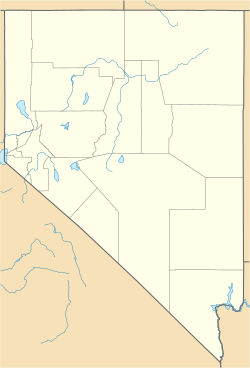The Glenbrook facts for kids
Quick facts for kids The Glenbrook |
||
| [[Image:The Glenbrook NRHP 81000702 Carson City, NV.jpg | alt=]] | |
| Power type | Steam | |
|---|---|---|
| Reference: | ||
| Builder | Baldwin Locomotive Works | |
| Build date | 1875 | |
| Total production | 2 | |
| Configuration | 2-6-0 | |
| Gauge | 3 ft (914 mm) | |
| Locomotive weight | 26 short tons (24 t; 23 long tons) | |
| Fuel type | Wood | |
| Cylinders | 2 | |
| Number in class | 2 | |
| Current owner | Nevada State Railroad Museum | |
| Disposition | Operational at the Nevada State Railroad Museum | |
|
The Glenbrook
|
||
| Location | 600 N. Carson St., Carson City, Nevada | |
| Area | 1 acre (0.40 ha) | |
| Built | 1875 | |
| Architect | Baldwin Locomotive Works | |
| Architectural style | Steam Locomotive | |
| NRHP reference No. | 81000702 | |
| Added to NRHP | May 01, 1981 | |
The Glenbrook is a special kind of steam train built a long time ago in 1875. It's a "Mogul" type, which means it has a specific wheel arrangement (2-6-0). This train was made by a company called Baldwin Locomotive Works. It was built for the Carson and Tahoe Lumber and Fluming Company. This company had a narrow-gauge railroad, which means its tracks were narrower than regular train tracks. The Glenbrook ran on tracks that were 3 ft (914 mm) wide.
Contents
The Glenbrook's Early Life
The Glenbrook and its sister train, the Tahoe, were built for an important job. Their main task was to carry heavy loads of wood and lumber. They picked up these materials from Glenbrook, Nevada. This town is located on the east side of Lake Tahoe.
The trains would then haul the wood up to Spooner Summit. This summit is at the top of the Carson Range mountains. From there, the logs and lumber were put into a special flume. A flume is like a long, narrow channel that uses water to carry things.
This flume carried the wood all the way to the south end of Carson City, Nevada. Once in Carson City, the wood was loaded onto flatcars. These flatcars belonged to the Virginia and Truckee Railroad. This railroad then took the wood to Virginia City, Nevada.
The wood was used for many things in Virginia City. It helped build the town, provided timbers for mines, and was even used as fuel for boilers.
Changes and New Journeys
By 1890, most of the trees in the area had been cut down. The Bliss family, who owned the trains, sold the Tahoe to the Nevada County Narrow Gauge Railroad (NCNG).
In 1899, the Bliss family moved the train tracks and all the equipment. They took everything to Tahoe City, California. This town is on the northwest side of Lake Tahoe. From there, they built a new railroad line. This new line was about 22 miles (35 km) long. It connected to the Southern Pacific Railroad station in Truckee, California. Truckee is just east of Donner Pass.
This new line was called the Lake Tahoe Railway and Transportation (LTR&T). It carried both goods and people. It also connected with a large lake steamer called the SS Tahoe. This steamer was 169-foot (52 m) long.
A New Owner and Restoration
The Bliss family sold the LTR&T to the Southern Pacific in 1926. The Southern Pacific Railroad quickly changed the new branch line. They made its tracks wider to fit their standard-gauge trains.
The Bliss family decided to keep the Glenbrook (train #1). They stored it in Tahoe City until 1937. Then, they sold it to the Nevada County Narrow Gauge Railroad (NCNG). The NCNG mostly used parts from the Glenbrook to fix the Tahoe.
The NCNG stopped operating in 1942. But Hope Bliss convinced her family to buy the Glenbrook back. They then gave it to the Nevada State Museum and the Nevada State Railroad Museum. The train needed a lot of work there.
The Glenbrook was finally ready to run again in May 2015. It was shown to the public on May 23, 2015.
A Historic Landmark
The Glenbrook train is very important. It was added to the National Register of Historic Places in 1981. This means it is recognized as a special part of history.



